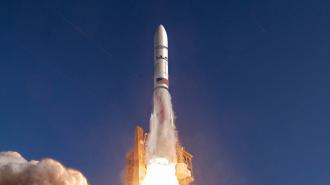Amazon is a major step closer to competing with SpaceX in the satellite internet space, as its Project Kuiper prototypes have aced their first tests in space.
Internet satellites: Access to the internet means access to job opportunities, education, health information, and more, but about a third of the world population is still largely offline, and this is often because internet providers simply don’t service the places they live.
Satellite internet services could help close this digital divide — while expanding terrestrial internet coverage often means building costly infrastructure, with towers, cable, and fiber optics, satellite constellations can beam internet down to anywhere on Earth as long as there are enough of them in the sky.
“To get these results on your very first mission…is an incredible feat.”
Rajeev Badyal
Project Kuiper: In 2019 — the same year SpaceX deployed the first satellites in its Starlink internet constellation — Amazon announced Project Kuiper, an initiative to build its own satellite constellation to provide global internet service.
On October 6, Amazon launched the first two Project Kuiper test satellites, and it has now reported that both worked exactly as hoped, with a 100% success rate across all tests.
“Every single component is operating as designed,” Rajeev Badyal, Project Kuiper’s VP of technology, told Space News. “All the results are nominal or better.”
The demos: Satellite internet providers in low-Earth orbit need to deploy vast constellations of satellites because they can only deliver internet to ground-based terminals that they can see — a satellite whizzing over New York wouldn’t be able to provide internet access to someone in Australia, for example.
This significantly limited the Project Kuiper researchers’ ability to test their internet satellites — they only had 30-120 seconds of connectivity each time the prototypes flew over their test site in Texas.
Over the course of 30 days, the team was able to use those brief contact windows to test the satellites’ systems and perform three demonstrations: logging into Amazon Prime and making a purchase, logging into Amazon Video to start streaming a 4K movie, and conducting a two-way video call with an Amazon center in Washington over Amazon Chime.
Looking ahead: Now that Amazon knows the Project Kuiper prototypes work, it is going to start mass producing the satellites, with plans to begin deploying them at scale in the first half of 2024. It expects to be ready to beta test the service with select customers later that year.
“Kuiper was an idea on a piece of paper a few years ago, and everything we’ve learned so far from our Protoflight mission validates our original vision and architecture,” said Badyal.
“We still have a lot of hard work ahead, and scaling for mass production won’t be easy,” he continued. “To get these results on your very first mission, though — and so quickly after launch — is an incredible feat.”
We’d love to hear from you! If you have a comment about this article or if you have a tip for a future Freethink story, please email us at tips@freethink.com.
